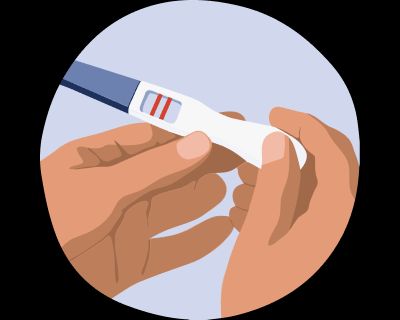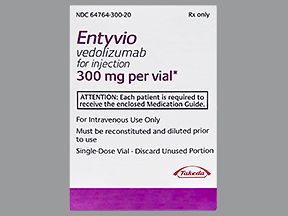Entyvio is a brand-name prescription drug that’s prescribed for active Crohn’s disease and ulcerative colitis. It’s given as an intravenous (IV) infusion and subcutaneous injection. The dosage can vary depending on your treatment plan.
Entyvio contains the active ingredient vedolizumab, which is a biologic. It’s not available as a biosimilar.
Keep reading for specific information about the dosage of Entyvio, including its strengths and how it’s given. See this other article for a comprehensive look at Entyvio.
The following information describes the Entyvio dosage for treating Crohn’s disease (CD) and ulcerative colitis (UC) in adults.
Entyvio forms
Entyvio comes in the following forms:
- IV infusion (injection into a vein over time) that’s given by a doctor or another healthcare professional, typically at a clinic, hospital, or doctor’s office
- subcutaneous injection (injection under the skin) using a single-dose prefilled syringe or injection pen
Entyvio strengths
Entyvio IV infusion comes in one strength: 300 milligrams (mg).
Entyvio single-dose prefilled syringe and injection pen for subcutaneous injection comes in one strength: 108 mg/0.68 milliliters (mL)
Typical dosages
The following information describes dosages that are commonly prescribed or recommended. However, be sure to take the dosage your doctor prescribes for you. Your doctor will determine the best dosage to fit your needs.
Entyvio dosage for CD and UC
The Entyvio IV infusion dosage schedule and dose increases are the same for treating CD and UC.
You’ll start with an induction dosage of Entyvio. This refers to receiving doses more often at the start of treatment than later during treatment. This is done to get enough medication in your body for Entyvio to start working quickly. (An induction dose is different from a loading dose, which is a higher dose at the start of treatment.)
Entyvio’s induction dose schedule is 300 mg given at week 0 and week 2.
After finishing this starting dosage, you’ll switch to a maintenance dose to continue treatment at week 6. A maintenance dose maintains a steady level of the drug in your body over time.
Entyvio’s maintenance dosage can be given through IV infusion or through subcutaneous injection at home. The dosages for each method of administration are as follows:
- With IV infusion: 300 mg every 8 weeks
- With subcutaneous injection: 108 mg every 2 weeks
If you have questions about your Entyvio dosage, talk with your doctor or pharmacist.
Long-term use
Entyvio is meant to be used as a long-term treatment. If you and your doctor determine that Entyvio is safe and effective for you, you’ll likely use it long term.
If Entyvio doesn’t reduce your CD or UC symptoms after 14 weeks of treatment, your doctor may have you stop treatment. They may recommend other treatments for your condition.
Discover more about Entyvio
Below are some answers to frequently asked questions about Entyvio dosages.
Why is Entyvio IV infusion eventually given every 8 weeks instead of every 4 weeks?
Entyvio IV infusion is given every 8 weeks as a maintenance dose because this frequency was safe and effective in treating CD and UC in clinical trials. It’s given every 8 weeks after the first two induction doses. (For more details, see the “Entyvio dosage” section.)
Clinical trials found that giving Entyvio IV infusion every 4 weeks was not more effective than giving it every 8 weeks. Because of this, having Entyvio infusions every 4 weeks is not recommended.
If you have more questions about Entyvio IV infusion dosing, talk with your doctor or pharmacist.
What is Entyvio’s dosing for children?
Entyvio is not approved for use in children. This drug has not been studied in children, so it’s not known whether it’s safe and effective for this age group.
If you’re interested in CD or UC medications for children and what your child’s dosing would be, talk with your child’s doctor.
Entyvio can be given using an IV infusion or subcutaneous injection.
Entyvio IV infusion
Entyvio is first given by a healthcare professional as an IV infusion. Entyvio infusions usually last about 30 minutes. You’ll go to an infusion clinic, hospital, doctor’s office, or similar place for Entyvio infusions. You may also be able to receive infusions at home, depending on your treatment plan and insurance coverage.
During your infusions, you’ll be closely monitored for any Entyvio side effects related to the infusion.
Here are some tips that can help you prepare for an Entyvio infusion:
- Drink plenty of fluids the day before and the day of your infusion.
- If you have an infection or are feeling sick, call your doctor before your appointment. They may suggest rescheduling your infusion.
- Dress in layers. Some people feel cold during their infusions.
- Bring a snack or food, especially if your infusion is at a time when you’d usually eat.
- Bring entertainment, such as a book or a mobile device.
Make sure to follow any other instructions from your doctor about how to prepare for your Entyvio infusions.
Entyvio subcutaneous injection
After your first Entyvio infusions, you may be able to give yourself Entyvio doses at home using the subcutaneous injection. These can be given using a single-dose prefilled syringe or single-dose prefilled injection pen.
Your doctor will show you or your caregiver how to give Entyvio injections at home. Be sure to follow their instructions. You can also view the Entyvio pen instructions for use or the Entyvio syringe medication guide.
Below are some tips that can help you prepare for an Entyvio injection at home:
- Store the Entyvio syringe or pen in the refrigerator between 36°F to 46°F (2°C to 8°C).
- Wait 30 minutes to let the syringe or pen come to room temperature before injecting your dose.
- Check the solution for discoloration and to make sure there’s nothing floating in it. Do not use the syringe or pen if the solution is discolored or has floaters in it.
- You can inject Entyvio into your abdomen (2 inches away from the navel) or thigh. A caregiver may inject it into your upper arm. Do not inject into any tender, red, discolored, or hardened areas of the skin. And don’t inject into moles, scars, or bruises. Be sure to administer each injection in a different spot than the last injection.
If you miss an Entyvio infusion appointment, reschedule the infusion as soon as possible. Contact your doctor or the place where you receive your infusions.
To help make sure that you don’t miss an appointment, try using a medication reminder. This can include setting an alarm or timer on your phone or downloading a reminder app.
If you miss an Entyvio subcutaneous injection at home, inject the next dose as soon as possible. Then inject it every 2 weeks afterward.
If you’re not sure whether you gave yourself a full Entyvio dose, talk with your doctor or pharmacist. They’ll advise on the next best steps.
Disclaimer: Medical News Today has made every effort to make certain that all information is factually correct, comprehensive, and up to date. However, this article should not be used as a substitute for the knowledge and expertise of a licensed healthcare professional. You should always consult your doctor or another healthcare professional before taking any medication. The drug information contained herein is subject to change and is not intended to cover all possible uses, directions, precautions, warnings, drug interactions, allergic reactions, or adverse effects. The absence of warnings or other information for a given drug does not indicate that the drug or drug combination is safe, effective, or appropriate for all patients or all specific uses.






